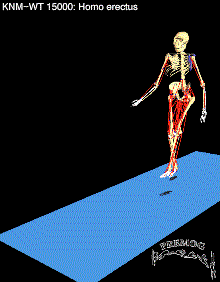The first species to migrate from Africa during the Pleistocene glacial period was Homo erectus. This species was widely disbursed in the time frame of 1.8 - 1 million years ago. They inhabited the regions of southeastern and eastern Asia until approximately 300 000 years ago. Europe, India, China and Indonesia have all yielded evidence of Homo erectus.
(Wicander and Monroe 1993)
Characteristics of Homo erectus are a brain capacity of 800 - 1300 cc, a large face and thick skull, brow ridges and a forehead that recedes. "Tukana Boy" was an African discovery, which shows that Homo erectus had a similar body size to humans. The period that this boy lived in was 1.6 million years ago. (Wicander and Monroe 1993)
Being able to construct tools, such as hand axes, was within the capacity of Homo erectus. Homo erectus, according to some studies, made use of fire and occupied caves.
(Wicander and Monroe 1993)
|
HOMO ERECTUS
|
The material culture of H. erectus was significantly more complex than that of its predecessors, including Achuelian stone tools (see Paleolithic), a variety of tools fashioned from wood and other perishable materials, the use of fire, and seasonally occupied, oval-shaped huts. Evidence of extensive cooperative behavior is abundant in a number of European habitation and hunting sites, including Terra Amata, France, and Terralba and Ambrona, Spain. H. erectus populations occupied these sites seasonally, while pursuing an annual subsistence cycle based on a combination of big-game hunting and the gathering of shellfish and plant foods.
This is a model of a 1.5 million year old Homo Erectus specimen, a teenage boy from the site of Nariokotome, west of Lake Turkana in Kenya. This is the most complete skeleton known of all fossil homonids. Blue portions of bone are mirrored and white portions of bone are reconstructed from modern bones.
|

